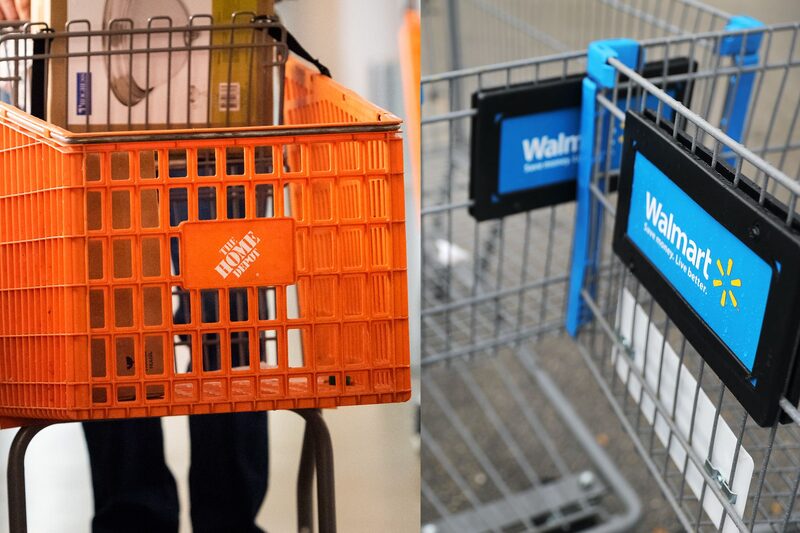Bloomberg Opinion — Should Walmart Inc. merge with Home Depot Inc.? There may be a container ship worth of reasons for them to consider it.
Walmart and Home Depot are among U.S. retailers that have grown so frustrated with the limited space on container ships and rising cost of ocean shipping that they’ve begun chartering their own vessels to speed the journey from factories on one side of the world to consumers on the other. Costco Wholesale Corp. also resorted to this option recently rather than risk having key items out of stock heading into the holidays.
The reasons for the global freight congestion are numerous and complex, but one critical moment came in March when a mega-freighter ran aground in the Suez Canal, a crucial waterway for global trade. Unable to handle the heightened demand for goods, the system remains backed up — even on land, where there’s a dearth of truck drivers. Shipping has become so expensive in the process that Bed Bath & Beyond Inc.’s executives said last week that they experienced a 360 basis point surge in freight costs, which was well above the already steep increase they had budgeted for last quarter.

Cutting down on costs to bolster profitability is one of the chief reasons companies pursue mergers and acquisitions, and so it’s quite possible that sustained supply-chain bottlenecks will spur some previously unfathomable unions. The idea for Walmart and Home Depot to combine comes from Brittain Ladd, an industry analyst with supply-chain solutions company Kuecker Pulse Integration and a longtime consultant to the retail industry. That’s just one possible deal permutation, although the case is convincing.
Walmart is the top U.S. importer of goods by container ship, followed by Target Corp. and then Home Depot, according to the Journal of Commerce’s annual ranking. “Imagine their combined ability to collaborate on procurement,” Ladd said in a phone interview. Not only could they negotiate better rates, but they could even acquire their own ships and sell excess capacity to other businesses by forming a logistics unit. This is a bit like the vertical integration Amazon.com Inc. has started assembling.
“Supply chains have always had an element of risk to them because supply chains in most cases are truly global,” Ladd said. “But what we’re also seeing today are supply chains that are in many ways too lean and paying for it. This is one of the best reasons for very large retailers and other companies to say, ‘We need to start thinking big in our M&A and use it to reimagine our supply chains.’”
The strategic rationale for a Walmart-Home Depot deal extends beyond that, though. Walmart stores could use a refresh, and as groceries increasingly drive Walmart’s revenue, Home Depot could become the overarching label or overseer of non-grocery items. Ladd envisions a Home Depot-branded do-it-yourself section at Walmart, a bit like Target is doing with Ulta Beauty Inc. for makeup. “The Walmart of 1970 doesn’t look that much different from the Walmart of 2021,” he said. “This is a way to jazz up their brand.” Greater visibility and control over inventory would allow them to modernize with dynamic pricing — i.e., getting rid of static paper stickers and adapting prices quickly to stoke demand and offer spot promotions, he said. Or perhaps they could expand into a new adjacent product category such as a private-label furniture line to compete online with Wayfair Inc., which has carved out its own supply-chain advantage.
There are obstacles: For one, their size — Walmart and Home Depot are valued at more than $340 billion each. And antitrust regulators may take issue with the idea. But it illustrates a concept that could apply to other sets of retailers. The broader brick-and-mortar retail industry isn’t known for being very active, or very successful, in big strategic M&A. Even Amazon’s once-feared purchase of Whole Foods Market didn’t accomplish much of note. An alternative to a full-blown merger is to just strike an alliance, as European grocers Carrefour SA and Tesco Plc did, pooling their buying power to gain more negotiating power with suppliers and manufacturers. Still, it was a temporary arrangement that the companies decided to end this year.
For huge retailers, there’s an added incentive now to assert greater control over their supply chains, and takeovers could be the way to do it. If Walmart wants to think outside the cargo box, Home Depot is an option.
This column does not necessarily reflect the opinion of the editorial board or Bloomberg LP and its owners.
Tara Lachapelle is a Bloomberg Opinion columnist covering the business of entertainment and telecommunications, as well as broader deals. She previously wrote an M&A column for Bloomberg News.

